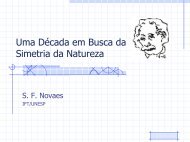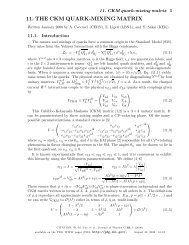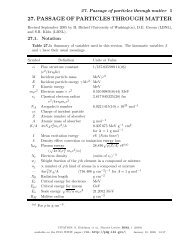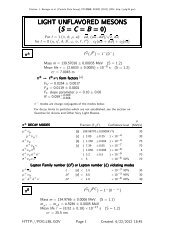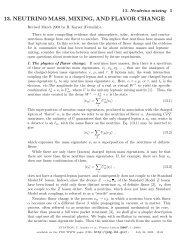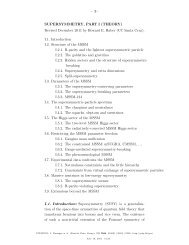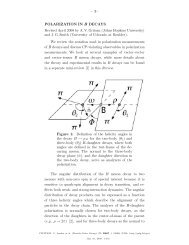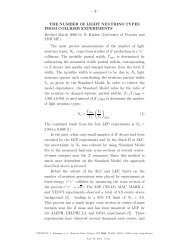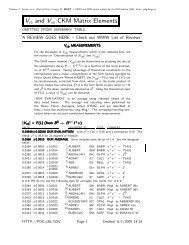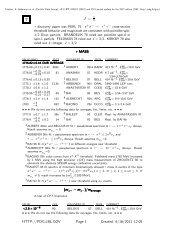Υ(4S) - Particle Data Group
Υ(4S) - Particle Data Group
Υ(4S) - Particle Data Group
Create successful ePaper yourself
Turn your PDF publications into a flip-book with our unique Google optimized e-Paper software.
Citation: K. Nakamura et al. (<strong>Particle</strong> <strong>Data</strong> <strong>Group</strong>), JP G 37, 075021 (2010) and 2011 partial update for the 2012 edition (URL: http://pdg.lbl.gov)<br />
<strong>Υ</strong>(<strong>4S</strong>)<br />
or <strong>Υ</strong>(10580)<br />
I G (J PC ) = 0 − (1 −− )<br />
<strong>Υ</strong>(<strong>4S</strong>) MASS<br />
VALUE (GeV) DOCUMENT ID TECN COMMENT<br />
10.5794±0.0012 OUR AVERAGE<br />
10.5793±0.0004 ±0.0012 AUBERT 05Q BABR e + e − → hadrons<br />
10.5800±0.0035 1 BEBEK 87 CLEO e + e − → hadrons<br />
•••We do not use the following data for averages, fits, limits, etc. •••<br />
10.5774±0.0010 2 LOVELOCK 85 CUSB e + e − → hadrons<br />
1 Reanalysis of BESSON 85.<br />
2 No systematic error given. <strong>Υ</strong>(<strong>4S</strong>) WIDTH<br />
VALUE (MeV) DOCUMENT ID TECN COMMENT<br />
20.5±2.5 OURAVERAGE<br />
20.7±1.6±2.5 AUBERT 05Q BABR e + e − → hadrons<br />
20 ±2 ±4 BESSON 85 CLEO e + e − → hadrons<br />
•••We do not use the following data for averages, fits, limits, etc. •••<br />
25 ±2.5 LOVELOCK 85 CUSB e + e − → hadrons<br />
<strong>Υ</strong>(<strong>4S</strong>) DECAYMODES<br />
Mode Fraction (Γ i /Γ) Confidence level<br />
Γ 1 B B > 96 % 95%<br />
Γ 2 B + B − (51.6 ±0.6 ) %<br />
Γ 3 D + s<br />
anything + c.c. (17.8 ±2.6 ) %<br />
Γ 4 B 0 B 0 (48.4 ±0.6 ) %<br />
Γ 5 J/ψ K 0 S (J/ψ, η c)K 0 S<br />
< 4 × 10 −7 90%<br />
Γ 6 non-B B < 4 % 95%<br />
Γ 7 e + e − ( 1.57±0.08) × 10 −5<br />
Γ 8 ρ + ρ − < 5.7 × 10 −6 90%<br />
Γ 9 J/ψ(1S) anything < 1.9 × 10 −4 95%<br />
Γ 10 D ∗+ anything + c.c. < 7.4 % 90%<br />
Γ 11 φ anything ( 7.1 ±0.6 ) %<br />
Γ 12 φη < 1.8 × 10 −6 90%<br />
Γ 13 φη ′ < 4.3 × 10 −6 90%<br />
Γ 14 ρη < 1.3 × 10 −6 90%<br />
Γ 15 ρη ′ < 2.5 × 10 −6 90%<br />
HTTP://PDG.LBL.GOV Page 1 Created: 6/16/2011 12:05
Citation: K. Nakamura et al. (<strong>Particle</strong> <strong>Data</strong> <strong>Group</strong>), JP G 37, 075021 (2010) and 2011 partial update for the 2012 edition (URL: http://pdg.lbl.gov)<br />
Γ 16 <strong>Υ</strong>(1S) anything < 4 × 10 −3 90%<br />
Γ 17 <strong>Υ</strong>(1S)π + π − ( 8.1 ±0.6 )× 10 −5<br />
Γ 18 <strong>Υ</strong>(1S)η ( 1.96±0.11) × 10 −4<br />
Γ 19 <strong>Υ</strong>(2S)π + π − ( 8.6 ±1.3 )× 10 −5<br />
Γ 20 d anything < 1.3 × 10 −5 90%<br />
<strong>Υ</strong>(<strong>4S</strong>) PARTIAL WIDTHS<br />
Γ ( e + e −) Γ 7<br />
VALUE (keV) DOCUMENT ID TECN COMMENT<br />
0.272±0.029 OUR AVERAGE Error includes scale factor of 1.5. See the ideogram below.<br />
0.321±0.017±0.029 AUBERT 05Q BABR e + e − → hadrons<br />
0.28 ±0.05 ±0.01 3 ALBRECHT 95E ARG e + e − → hadrons<br />
0.192±0.007±0.038 BESSON 85 CLEO e + e − → hadrons<br />
0.283±0.037 LOVELOCK 85 CUSB e + e − → hadrons<br />
3 Using LEYAOUANC 77 parametrization of Γ(s).<br />
WEIGHTED AVERAGE<br />
0.272±0.029 (Error scaled by 1.5)<br />
0 0.1 0.2 0.3 0.4 0.5 0.6<br />
(<br />
Γ e + e −) (keV)<br />
AUBERT 05Q BABR<br />
χ 2<br />
2.1<br />
ALBRECHT 95E ARG 0.0<br />
BESSON 85 CLEO 4.3<br />
LOVELOCK 85 CUSB 0.1<br />
6.5<br />
(Confidence Level = 0.089)<br />
<strong>Υ</strong>(<strong>4S</strong>) BRANCHING RATIOS<br />
B B DECAYS<br />
The ratio of branching fraction to charged and neutral B mesons is often<br />
derived assuming isospin invariance in the decays, and relies on the<br />
knowledge of the B + /B 0 lifetime ratio. “OUR EVALUATION” is obtained<br />
based on averages of rescaled data listed below. The average and<br />
HTTP://PDG.LBL.GOV Page 2 Created: 6/16/2011 12:05
Citation: K. Nakamura et al. (<strong>Particle</strong> <strong>Data</strong> <strong>Group</strong>), JP G 37, 075021 (2010) and 2011 partial update for the 2012 edition (URL: http://pdg.lbl.gov)<br />
rescaling were performed by the Heavy Flavor Averaging <strong>Group</strong> (HFAG)<br />
and are described at http://www.slac.stanford.edu/xorg/hfag/. The averaging/rescaling<br />
procedure takes into account the common dependence<br />
of the measurement on the value of the lifetime ratio.<br />
Γ ( B + B −) /Γ total Γ 2 /Γ<br />
VALUE<br />
DOCUMENT ID<br />
0.516±0.006 OUR EVALUATION Assuming B(<strong>Υ</strong>(<strong>4S</strong>) → B B) =1<br />
Γ ( D + s<br />
anything + c.c. ) /Γ total Γ 3 /Γ<br />
VALUE DOCUMENT ID TECN COMMENT<br />
0.178±0.021±0.016 4 ARTUSO 05B CLE3 e + e − → Dx X<br />
4<br />
(<br />
ARTUSO 05B reports [Γ <strong>Υ</strong>(<strong>4S</strong>) → D<br />
+<br />
anything + c.c. ) /Γ s total ] × [B(D + s → φπ+ )]<br />
=(8.0 ± 0.2 ± 0.9) × 10 −3 which we divide by our best value B(D + → φπ<br />
s<br />
+ )=<br />
(4.5 ± 0.4) × 10 −2 . Our first error is their experiment’s error and our second error is<br />
the systematic error from using our best value.<br />
Γ ( B 0 B 0) /Γ total Γ 4 /Γ<br />
VALUE DOCUMENT ID TECN COMMENT<br />
0.484±0.006 OUR EVALUATION Assuming B(<strong>Υ</strong>(<strong>4S</strong>) → B B) =1<br />
•••We do not use the following data for averages, fits, limits, etc. •••<br />
0.487±0.010±0.008 5 AUBERT,B 05H BABR <strong>Υ</strong>(<strong>4S</strong>) → BB → D ∗ lνl<br />
5 Direct measurement. This value is averaged with the value extracted from the Γ(B + B − )<br />
/Γ(B 0 B 0 ) measurements.<br />
Γ ( B + B −) /Γ ( B 0 B 0) Γ 2 /Γ 4<br />
VALUE DOCUMENT ID TECN COMMENT<br />
1.065±0.026 OUR EVALUATION<br />
1.006±0.036±0.031 6 AUBERT 04F BABR <strong>Υ</strong>(<strong>4S</strong>) → B B → J/ψ K<br />
1.01 ±0.03 ±0.09 6 HASTINGS 03 BELL <strong>Υ</strong>(<strong>4S</strong>) → B B → dileptons<br />
1.058±0.084±0.136 7 ATHAR 02 CLEO <strong>Υ</strong>(<strong>4S</strong>) → B B → D ∗ lν<br />
1.10 ±0.06 ±0.05 8 AUBERT 02 BABR <strong>Υ</strong>(<strong>4S</strong>) → B B → (c c )K ∗<br />
1.04 ±0.07 ±0.04 9 ALEXANDER 01 CLEO <strong>Υ</strong>(<strong>4S</strong>) → B B → J/ψ K ∗<br />
6 HASTINGS 03 and AUBERT 04F assume τ(B + )/τ(B 0 )=1.083 ± 0.017.<br />
7 ATHAR 02 assumes τ(B + )/τ(B 0 )=1.074 ± 0.028. Supersedes BARISH 95.<br />
8 AUBERT 02 assumes τ(B + )/τ(B 0 )=1.062 ± 0.029.<br />
9 ALEXANDER 01 assumes τ(B + )/τ(B 0 )=1.066 ± 0.024.<br />
Γ ( J/ψ K 0 S (J/ψ, η c)K 0<br />
S) /Γtotal Γ 5 /Γ<br />
Forbidden by CP invariance.<br />
VALUE (units 10 −7 ) CL% DOCUMENT ID TECN COMMENT<br />
Citation: K. Nakamura et al. (<strong>Particle</strong> <strong>Data</strong> <strong>Group</strong>), JP G 37, 075021 (2010) and 2011 partial update for the 2012 edition (URL: http://pdg.lbl.gov)<br />
Γ ( e + e −) /Γ total Γ 7 /Γ<br />
VALUE (units 10 −5 ) DOCUMENT ID TECN COMMENT<br />
(1.57+-0.08) OUR AVERAGE<br />
1.55±0.04±0.07 AUBERT 05Q BABR e + e − → hadrons<br />
2.77±0.50±0.49 11 ALBRECHT 95E ARG e + e − → hadrons<br />
11 Using LEYAOUANC 77 parametrization of Γ(s).<br />
Γ ( ρ + ρ −) /Γ total Γ 8 /Γ<br />
VALUE CL% DOCUMENT ID TECN COMMENT<br />
Citation: K. Nakamura et al. (<strong>Particle</strong> <strong>Data</strong> <strong>Group</strong>), JP G 37, 075021 (2010) and 2011 partial update for the 2012 edition (URL: http://pdg.lbl.gov)<br />
Γ ( ρη ′) /Γ total Γ 15 /Γ<br />
VALUE (units 10 −6 ) CL% DOCUMENT ID TECN COMMENT<br />
Citation: K. Nakamura et al. (<strong>Particle</strong> <strong>Data</strong> <strong>Group</strong>), JP G 37, 075021 (2010) and 2011 partial update for the 2012 edition (URL: http://pdg.lbl.gov)<br />
Γ ( <strong>Υ</strong>(2S)π + π −) /Γ total Γ 19 /Γ<br />
VALUE (units 10 −4 ) CL% EVTS DOCUMENT ID TECN COMMENT<br />
0.86±0.11±0.07 220 26 AUBERT 08BP BABR <strong>Υ</strong>(<strong>4S</strong>) → π + π − l + l −<br />
•••We do not use the following data for averages, fits, limits, etc. •••<br />
0.88±0.17±0.08 97 ± 15 27 AUBERT 06R BABR e + e − → π + π − μ + μ −<br />



